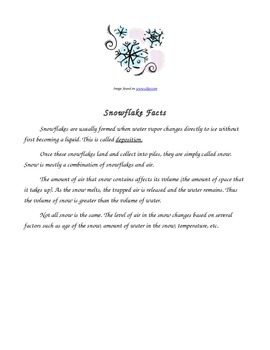Snow Science! How Dense is Our Snow? A Hands On Science Experiment.
WonbyOne
394 Followers
Grade Levels
3rd - 8th, Homeschool
Subjects
Resource Type
Standards
CCSS4.MD.B.4
CCSS5.MD.B.2
CCSS3.NF.A.1
CCSS6.SP.A.1
CCSSW.3.7
Formats Included
- Word Document File
Pages
11 pages
WonbyOne
394 Followers
Description
When the snow starts falling, students love to play around in it. Here is a science experiment that ties in their love of snow with learning! This Science Experiment measures the amount of liquid in snow and leads to a discussion on density. I tie this experiment to an introduction to our fractions unit in math. Even in 5th grade students need a reminder that fractions are a part of a whole. They will also get to see a real world example of when fractions, graphs, and line plots are used to help understand information. Students in younger grades won't need the worksheets but the questions on them can be done as a class. This experiment can be done in one or two days depending on available time. You will need to do some other lesson while you wait for snow to melt. My name is Melanie Whitesides and I would appreciate any suggestions to improve it. Thank you.
Snow Science - How Dense is Our Snow? Hands on Science Experiment by Melanie Whitesides is licensed under a Creative Commons Attribution-NonCommercial-ShareAlike 4.0 International License.
Snow Science - How Dense is Our Snow? Hands on Science Experiment by Melanie Whitesides is licensed under a Creative Commons Attribution-NonCommercial-ShareAlike 4.0 International License.
Total Pages
11 pages
Answer Key
N/A
Teaching Duration
90 minutes
Last updated Jan 11th, 2014
Report this resource to TPT
Reported resources will be reviewed by our team. Report this resource to let us know if this resource violates TPT’s content guidelines.
Standards
to see state-specific standards (only available in the US).
CCSS4.MD.B.4
Make a line plot to display a data set of measurements in fractions of a unit (1/2, 1/4, 1/8). Solve problems involving addition and subtraction of fractions by using information presented in line plots. For example, from a line plot find and interpret the difference in length between the longest and shortest specimens in an insect collection.
CCSS5.MD.B.2
Make a line plot to display a data set of measurements in fractions of a unit (1/2, 1/4, 1/8). Use operations on fractions for this grade to solve problems involving information presented in line plots. For example, given different measurements of liquid in identical beakers, find the amount of liquid each beaker would contain if the total amount in all the beakers were redistributed equally.
CCSS3.NF.A.1
Understand a fraction 1/𝘣 as the quantity formed by 1 part when a whole is partitioned into 𝘣 equal parts; understand a fraction 𝘢/𝑏 as the quantity formed by 𝘢 parts of size 1/𝘣.
CCSS6.SP.A.1
Recognize a statistical question as one that anticipates variability in the data related to the question and accounts for it in the answers. For example, “How old am I?” is not a statistical question, but “How old are the students in my school?” is a statistical question because one anticipates variability in students’ ages.
CCSSW.3.7
Conduct short research projects that build knowledge about a topic.




